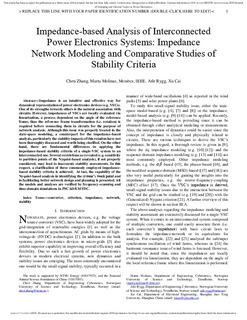| dc.contributor.author | Zhang, Chen | |
| dc.contributor.author | Molinas Cabrera, Maria Marta | |
| dc.contributor.author | Rygg, Atle | |
| dc.contributor.author | Cai, Xu | |
| dc.date.accessioned | 2019-08-16T12:02:59Z | |
| dc.date.available | 2019-08-16T12:02:59Z | |
| dc.date.created | 2019-05-08T10:31:48Z | |
| dc.date.issued | 2019 | |
| dc.identifier.issn | 2168-6777 | |
| dc.identifier.uri | http://hdl.handle.net/11250/2608767 | |
| dc.description.abstract | Impedance is an intuitive and effective way for dynamical representation of power electronics devices (e.g. VSCs). One of its strengths towards others is the natural association with circuits. However, impedances of VSCs are locally evaluated via linearization, a process dependent on the angle of the reference frame, thus the reference frame transformation (i.e. rotation) is required before connecting them in circuits for the purpose of network analysis. Although this issue was properly treated in the state-space modeling, a counterpart for the impedance-based analysis, particularly the stability impacts of this rotation have not been thoroughly discussed and worth being clarified. On the other hand, there are fundamental differences in applying the impedance-based stability criteria of a single-VSC system to an interconnected one. Several restrictions as revealed (e.g. sensitivity to partition points of the Nyquist-based analysis), if not properly considered, may lead to inaccurate stability assessments. In this respect, a clarification of three commonly employed impedancebased stability criteria is achieved. At last, the capability of the Nyquist-based analysis in identifying the system’s weak point and in facilitating better network design and planning is presented. All the models and analyses are verified by frequency-scanning and time-domain simulations in PSCAD/EMTDC. | nb_NO |
| dc.language.iso | eng | nb_NO |
| dc.publisher | Institute of Electrical and Electronics Engineers (IEEE) | nb_NO |
| dc.title | Impedance-based Analysis of Interconnected Power Electronics Systems: Impedance Network Modeling and Comparative Studies of Stability Criteria | nb_NO |
| dc.type | Journal article | nb_NO |
| dc.type | Peer reviewed | nb_NO |
| dc.description.version | acceptedVersion | nb_NO |
| dc.source.journal | IEEE Journal of Emerging and Selected Topics in Power Electronics | nb_NO |
| dc.identifier.doi | 10.1109/JESTPE.2019.2914560 | |
| dc.identifier.cristin | 1696256 | |
| dc.description.localcode | © 2018 IEEE. Personal use of this material is permitted. Permission from IEEE must be obtained for all other uses, in any current or future media, including reprinting/republishing this material for advertising or promotional purposes, creating new collective works, for resale or redistribution to servers or lists, or reuse of any copyrighted component of this work in other works. | nb_NO |
| cristin.unitcode | 194,63,25,0 | |
| cristin.unitname | Institutt for teknisk kybernetikk | |
| cristin.ispublished | false | |
| cristin.fulltext | preprint | |
| cristin.qualitycode | 1 | |
